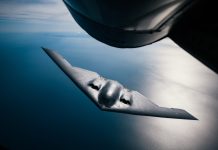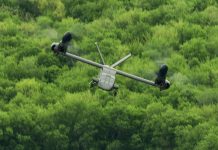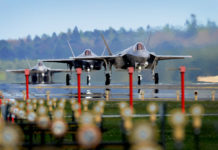The US Army currently operates more than 1,700 UH-60 BLACKHAWK helicopters. These utility helicopters constitute the primary air assault platform for light infantry. They also perform logistics, Casualty Evacuation (CASEVAC) and Search & Rescue (SAR) missions.
The UH-60 family was introduced in 1979. There have been repeated upgrade programmes to enhance performance and extend service life, but introduction of a successor aircraft has become pressing. Obsolescence and materiel fatigue are not the only reasons replacing the UH-60 is vital. The spectre of war with a peer power, or with a regional power utilising modern air-defence weapons, requires the United States to field an assault/utility helicopter equipped with the most advanced avionics, sensors, and performance parameters.
FLRAA Programme
The Future Long Range Assault Aircraft (FLRAA) programme seeks to provide a UH-60
replacement for the US Army, the US Marine Corps (USMC), and the joint service US Special Operations Command (SOCOM). Programme management lies with the Army. While FLRAA is intended to be multi-mission capable (mirroring the operational spectrum of the BLACKHAWK), the armed forces are focussed on the air assault mission as the primary “raison d’etre.”
The new medium-lift aircraft will display significant performance enhancements compared to the UH-60. This includes dramatic increases in speed, range and endurance. The minimum acceptable or threshold cruising speed is 230 knots. The Army’s objective targets include a maximum continuos cruise speed of 280 knots, and an unrefueled mission radius of at least 300 nautical miles. The USMC, which is expected to acquire the second-largest FLRAA fleet, has set even higher performance standards (295 knots cruise speed and 450 nm range). These physical performance parameters largely reflect the unprecedented mobility challenges which would arise from a major war in East Asia. Over and above the longer distances anticipated in future wars, the enhanced speed and agility will also increase survivability in contested environments, and facilitate immediate exploitation of newly created openings in enemy defences.
Troop-carrying capacity in the air assault configuration is considered a vital factor in determining the ultimate selection of one contender over another. Here, again, the Pentagon has set a minimum capacity – 12 combat-ready soldiers – which exceeds the capacity of the UH-60. Other fundamental requirements include full networking and interoperability with other aircraft and ground forces operating in a multi-domain battlefield. Modularity and open-systems architecture will also be essential for maximising the FLRAA’s flexibility, keeping on-board systems up-to-date, and reducing operating cost.
The Contenders
In March 2020 the Army awarded contracts to two industry competitors – Bell-Textron and a Boeing-Sikorsky team – to participate in the FLRAA Competitive Demonstration and Risk Reduction (CD&RR) phase 1. That phase encompassed requirements derivation, tradeoff analysis and preliminary conceptual design. In March 2021 both competitors advanced to CD&RR phase 2, with a focus on integrating major subsystems and mission systems on the candidate airframes. Work under phase 2 will be performed through May 30, 2022.
“Through CD&RR efforts, Army leaders have had the ability to make early, informed decisions ensuring FLRAA capabilities are not only affordable, but that they meet Multi-Domain Operations requirements while delivering on an aggressive schedule that does not sacrifice rigor for speed,” said Brigadier General Rob Barrie, programme executive officer for Army aviation, upon award of the phase 2 contracts.
The two contenders have been flying technology demonstrator aircraft representative of the general design characteristics of the production aircraft they would construct. Military pilots and maintenance personnel have had access to the demonstrators, both to gain direct insight and to provide feedback to industry. In addition to hundreds of hours of flight testing, both aircraft have been intensely studied in mission integration laboratories and on propulsion test beds. Observations made and insights gained during the CD&RR phases will guide the contractors through the process of refining and/or adjusting their design and technology concepts. These insights also guide the military through the process of developing concepts of operation based on what performance characteristics can reasonably be expected.
Bell-Textron V-280 VALOR
The twin-motor Bell Textron V-280 VALOR technology demonstrator utilises tiltrotor propulsion, and bears some resemblance to the larger V-22 OSPREY made by the same firm. The V-280 features integrated cabin armor, and has a v-shaped tail which enhances maneuverability, especially at high speed. Top flight speed achieved during testing was 305 knots. Bell completed flight testing of the V-280 in June 2021, but continues to evaluate data gleaned since the first flight of the aircraft in December 2017.
Bell’s ultimate design proposal is expected to closely resemble the V-280, although it is likely that lessons learned during the demonstration phase will mandate some changes. Bell has the advantage – both with regard to performance and to optimised maintenance procedures – of more than 600,000 flight hours experience with the tiltrotor V-22. This propulsion technology is operationally proven. The propulsion system on the V-280 features a simplified drive system design, with pylon versus nacelle rotation. According to Bell, this eliminates ground heating and simplifies maintenance, especially in the field.
Other proven performance parameters include a 280 knot airspeed, and excellent mobility during low-speed flight operations including slalom flight manoeuvres. The fly-by-wire digital control system includes the option for unmanned flight control, freeing up the cockpit crew for additional functions. The V-280 is self deployable at ranges up to 1,700 nautical miles, with a combat radius – depending on configuration – of 500-800 nautical miles, significantly exceeding the Army’s requirements for long-range assault missions.
Bell also sets great store in force protection capability inherent in the Piloted Distributed Aperture Sensor (PDAS). Developed by Texron’s parent company Lockheed Martin, PDAS provides the aircrew with 360 degree situational awareness. It consists of a network of integrated sensors – including six infrared-capable cameras distributed around the hull of the V-280 – which are linked to cockpit and helmet displays via an open-architecture processor. The display can also be made available to personnel in the rear of the aircraft, including door gunners, hoist operators, or infantry preparing to debark.
Boeing-Sikorsky SB-1 DEFIANT
The Boeing-Sikorsky demonstrator platform for the CD&RR phase is designated the SB>1 DEFIANT. The twin-engine aircraft, which first flew in March 2019, is classified as a compound helicopter. Its propulsion system differs from conventional helicopters. It has two counter-rotating coaxial rotors and a rear-mounted pusher propellor. The former provide enhanced lift and stability compared to conventional rotor designs; the latter provides considerable forward thrust without tilting the axis of the main rotors.
On 18 January 2022 the team announced that the SB>1 had successfully completed its first complete mission profile flight. As described by Sikorsky’s chief DEFIANT test pilot, Bill Fell, the test “fully demonstrated Defiant’s ability to execute the FLRAA mission profile by flying 236 knots in level flight, then reducing thrust on the propulsor to rapidly decelerate as we approached the confined, and unimproved, landing zone. This type of level body deceleration allowed us to maintain situational awareness and view the landing zone throughout the approach and landing without the typical nose-up helicopter deceleration.”
The demonstrator had previously performed low-level flight operations in forested terrain, 60-degree banked turns, and sling-loaded a 2,400 kg Multiple Launch Rocket System.
The team announced in January 2021 that it will submit the DEFIANT X coaxial helicopter, which is based on the DEFIANT SB>1, as the formal entry for the production aircraft. Compared with the technology demonstrator, the proposed production design features reduced thermal signature, improved aerodynamic handling, and a tricycle landing gear to improve performance in austere environments. Additionally, autonomy capabilities have been integrated into the flight controls to enhance agility and responsiveness.
On February 10, 2022 the team announced that the Honeywell HTS7500 turboshaft engine had been selected to power the DEFIANT X. Honeywell has stated that the engine provides the most favorable power-to-weight ratio in its class of military helicopter turboshaft engines. The newly introduced HTS7500 will provide enhanced payload capacity and greater fuel efficiency, according to the accompanying Honeywell press release.
Air Launched Effects
Parallel to the airframe CC&DR phase 2 contracts awarded in early 2021, the Army also initiated contract solicitations to other firms to submit bids for vital subsystems, particularly open architecture avionics and mission-management systems.
“Crucial to the success of FLRAA’s objectives is the deliberate integration of a Modular Open Systems Approach (MOSA) into its requirements, acquisition and sustainment strategy,” an Army statement said. “MOSA is a critical enabler for improving lifecycle affordability, directly aligning with Army Aviation objectives to achieve sustained affordability and deliver continuous capability upgrades against future threats.”
Open architecture will also facilitate integration of exchangable mission systems, including so-called “Air-Launched Effects” or ALEs. As defined by the US Army, ALEs refers to a family of systems consisting of an air vehicle, payload(s), mission system applications, and associated support equipment designed to autonomously or semi-autonomously deliver effects as a single agent or as a member of a team. Depending on the carrier aircraft and the ALE configuration, effects can range from kinetic or electronic attack, to reconnaissance and surveillance. The technology is intended for use on legacy aircraft as well as on several classes of helicopter currently under development. When deployed on the FLRAA, ACE systems could enhance force protection by detecting and potentially neutralizing enemy air defences and other threats along the helicopter’s flight path.
RapidEdge™
Several firms are competing for ALE-related contracts. Collins Aerospace announced on 31 January 2022 that it had successfully demonstrated the RapidEdge™ Mission System designed to support ALE operations. In addition to laboratory based tests, the demonstration series also included integration of the mission system on the tube-launched Altius-700 UAS, which can provide helicopters with an on-board reconnaissance, counter-UAS, and ground attack capabilities.
As described by Collins Aerospace, the RapidEdge™ technology acts as the “brain” of the ALE system and includes radios for communication, solutions for handling multiple levels of classified data, mission computing, and autonomous behaviours of the air launched vehicles. “We designed our RapidEdge™ Mission System solution for this market with a robust and resilient open systems approach at a high technological and manufacturing readiness level,” said Heather Robertson, vice president and general manager, Integrated Solutions for Collins Aerospace. “The offering is primed to meet the Army’s aggressive program schedule while delivering a critical capability to the warfighter.”
The FLRAA will also be capable of operating jointly with larger unmanned aerial vehicles (Manned-UnManned Teaming), which could provide future aerial assault missions with even stronger reconnaissance and force protection assets. Regardless of which vendor wins the final contract, the FLRAA’s open architecture approach facilitates integration of multiple payloads and datalinks for collaborative cross-domain operations between airborne and ground forces.
Timeline Going Forward
The final Request for Proposals was issued to both firms in July 2021. Bids were due by the end of September of that year. Award of the prototype development contract to the winning firm is expected to be announced by the end of June, 2022. The virtual prototype development phase will begin upon contract award, and run through December 2023, culminating in a preliminary design review.
The virtual prototype phase will overlap with the physical prototype construction phase, which will begin during the third quarter of Fiscal Year (FY) 2023, and run through the second quarter of FY 2026. This phase will require delivery of six aircraft for the engineering and manufacturing development stage. The first of several prototypes could be delivered as early as the third quarter of FY 2025, with flight testing and evaluation – conducted jointly by the government and the vendor – to run through the end of FY 2029. The production and deployment phase is expected to begin in 2028 with a Low-Rate Initial Production order of eight aircraft.
The Army plans to equip the first operational unit in 2030. As the new aircraft is procured, the armed forces will begin retiring legacy UH-60 aircraft. However, acquiring a full fleet of FLRAA will take years. Modernised UH-60M and UH-60V helicopters will continue to operate alongside the new type, with the last units presumably not retiring until circa 2060. This will enable aviation brigades to deploy aircraft according to mission requirements and the operational environment, preserving the new aircraft for the more challenging scenarios.












